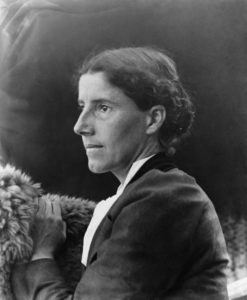
Charlotte Perkins was born on July 3, 1860, in Hartford, CT. Her father Fredric Beecher Perkins, was a highly educated intellectual but ultimately a failed provider for his family. He abandoned his wife and two children when Charlotte was an infant. Left in precarious financial circumstances, her mother Mary became dependent on the financial and emotional support of her husband’s aunts. Charlotte spent part of her childhood in the presence of two women who would fundamentally influence her perceptions of the world. One aunt was Harriet Beecher Stowe, the well-known author of Uncle Tom’s Cabin, and the other was Isabella Beecher Hooker, a prominent suffragette.
Though Charlotte was physically estranged from her father during her childhood, in his written communication with his daughter, he encouraged her intellectual growth by providing her with reading lists for scholarly works on the subjects of history, anthropology, and the sciences. Blessed with an agile mind and an intense curiosity, she became a voracious reader across a wide range of literature. While studying art at the Rhode Island School of Design, she met Charles Stetson whom she married in 1884.
One year later she gave birth to her daughter, Katharine. Shortly after the birth of her daughter, she slipped into the depths of a profound post-partum depression. During the late 19th century doctors championed the “rest cure treatment” for women suffering from depression. Under the supervision of Dr. Silas Mitchell, she was treated by prescribing a lengthy confinement to her bed. She was also discouraged from engaging in any physical or intellectual activities. Needless to say, the next two months spent in isolation not only did not “cure” her depression but made her condition worse. Charlotte ultimately decided that the restrictions placed upon her in her role as a wife were the underlying cause of her depression and separated from her husband, moving to Pasadena, California with her daughter.
This personal ordeal and the perversity of the “rest cure treatment” became the basis of her novel The Yellow Wallpaper in 1892. The theme of the novel critiqued the diminished status of women in American society based on the ingrained male-biased value system that viewed women as subservient to men. Her novel propelled her onto the national stage at a time when the political movement to amend the Constitution to allow women to vote was a prominent social issue. There was a popular demand for her services as a public speaker on the topic of women’s suffrage. Her next book, and perhaps her most important work, Women and Economics published in 1898, drew international attention. In this book, she advocated not only for the legal codification of the civil rights of women but a major transformation in the established institutions of marriage, child care, and the expansion of professional opportunities for women in the world of work.
In 1900 she married Houghton Gilman, a Wall Street lawyer, and they lived together in New York City. She moved to her husband’s old family homestead in Norwich, CT in 1922 where she resided until her husband’s death in 1934. Having been diagnosed with breast cancer in 1932, Charlotte Gilman moved back to California to live with her daughter. Gilman, a longtime advocate of euthanasia, took her own life on August 17, 1935.
For more examples of Charlotte Perkins Gilman’s work and images of one of the nation’s most historic champions for women’s rights, visit the historical photos on Otis Library’s website and Flickr.
For more examples of Charlotte Perkins Gilman’s work and images of one of the nation’s most historic champions for women’s rights visit the historical photos on the Otis Library website.

